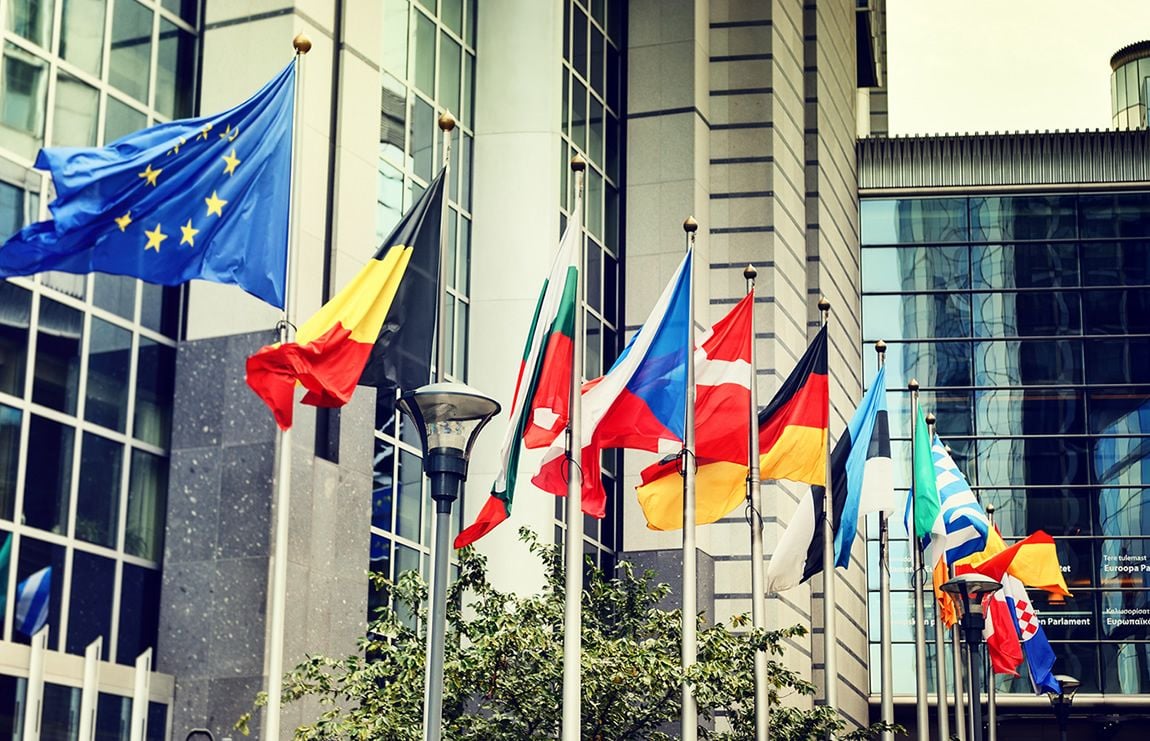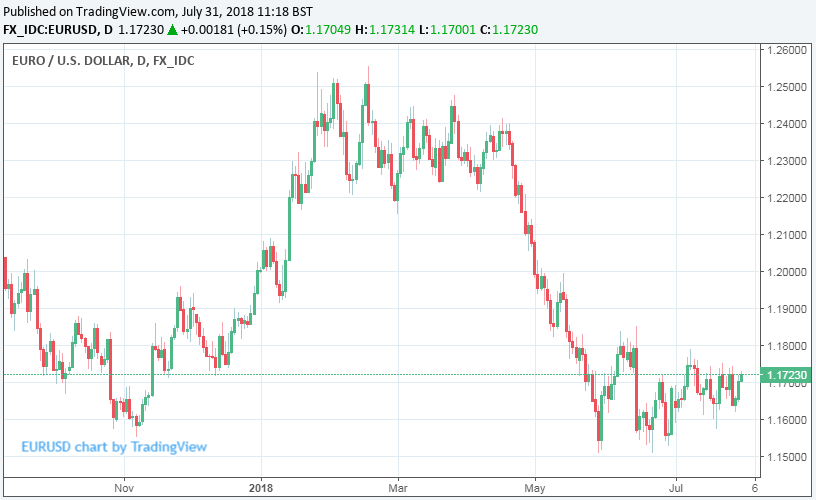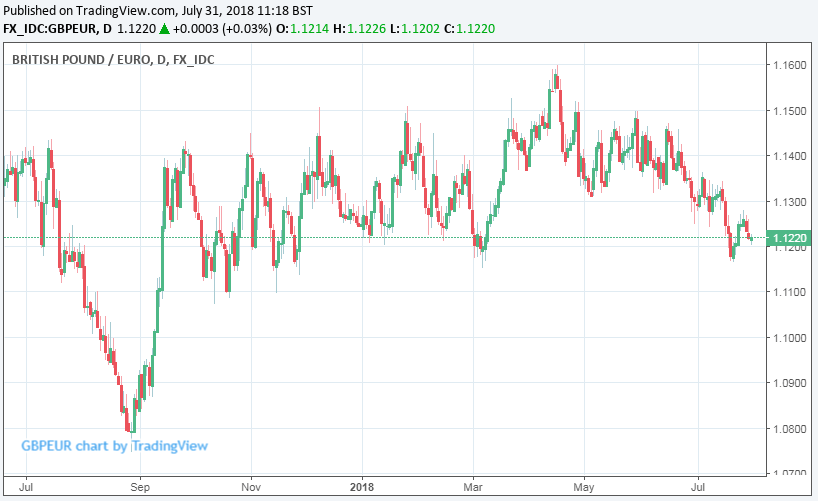Euro Treads Water after Eurozone Economy Slows in Second-quarter and Inflation Rises in July
- Written by: James Skinner
-
-Eurozone inflation rises further in July but economists are wary.
-Economy disappoints in second-quarter as growth slows to 2.1%.
-If anything, data push ECB interest rate rise further back into 2019.

© Grecaud Paul, Adobe Stock
The Euro saw volatile trading during the morning session Tuesday as markets digested a better-than-expected set of July inflation figures that came alongside a surprise disappointment in second-quarter Eurozone GDP data, which showed growth slowing across the bloc during the three months to the end of June.
Eurozone inflation rose at an annualised pace of 2.1% during July, which is up from 2% previously, ahead of consensus expectations for inflation of 2% and also above the 2% target of the European Central Bank.
Core which removes volatile food and energy items from the goods basket and so is seen as a more reliable measure of domestically generated inflation pressures, rose by 1.1% in July. This was up from the 0.9% rate seen back in June and also ahead of the market consensus for a reading of 1%.
"This improvement reflected higher energy inflation and some public holiday timing effects, so there is no guarantee that it will be sustained," says Jennifer McKeown, chief European economist at Capital Economics.
Currency markets care about the inflation data because consumer price pressure have a direct bearing on the interest rate and other monetary policy decisions of the European Central Bank, and it is changes in rates themselves that are the raison d'être for most moves in exchange rates.
Changes in interest rates, or hints of them being in the cards, are only made in response to movements in inflation but impact currencies because of the push and pull influence they have on international capital flows and their allure for short-term speculators.
McKeown says Tuesday's data is not enough to provide assurance of a sustainable return toward target for Eurozone inflation, which might at least partly explain the Euro's response to the data.

Above: Euro-to-Dollar rate shown at daily intervals.
The Euro was quoted 0.17% higher at 1.1728 following the report, which is in line with the Tuesday movement in other major currencies relative to the US Dollar.
The Pound-to-Euro rate was quoted 0.01% higher at 1.1221, underlining the extent to which the data underwhelmed the single currency.

Above: Pound-to-Euro rate shown at daily intervals.
Eurozone inflation must first make a sustainable return to the 2% target if the ECB is to be able to raise its interest rate.
Mario Draghi, the ECB's President, told reporters last week the Governing Council is confident that Euro area inflation will eventually converge with its target of "close to but below 2%" even after a likely end to its quantitative easing programme at the end of 2018.
When combined with Draghi's optimistic tone on the outlook for Euro area growth, the comments suggested the bank thinks it is on course to meet market expectations for an interest rate rise toward the end of 2019. But McKeown and some other economists are not as confident as Draghi.
"We doubt that the ECB will be deterred from its course of gradual policy normalisation yet. But interest rates seem unlikely to rise until September 2019 at the earliest and the Bank will keep open the option of extending its asset purchases into next year should the slowdown continue," McKeown writs, in a note to clients.
Growth Slows Further in Second-quarter
Separately, other data showed Eurozone economic growth slowing further during the second quarter, with GDP rising at an annualised pace of 2.1%. This is down from the 2.5% pace of growth seen in the three months to the end of March and far below the 2.7% growth seen in the final quarter of 2017.
"After a harsh winter and a flu epidemic had retarded growth temporarily in Q1, higher oil prices and trade tensions weighed on sentiment and demand in Q2. The surge in energy prices added 0.6ppt to the Eurozone’s annual inflation rate by June 2018, squeezing the amount of real income households have to spend on other goods and services," says Holger Schmieding, chief economist at Berenberg Bank.
Currency markets care about the GDP data because it reflects rising and falling demand within the Eurozone economy, which has a direct bearing on consumer price inflation, which is itself important for questions around interest rates.
"Expectations had weakened in the run-up to the release given mediocre monthly data and the modest 0.2% rise in French GDP, but the outturn was still below the consensus forecast (and our own) of 0.4%," McKeown remarks. "Data earlier this morning revealed that Spanish growth slowed to a four-year low of 0.6%. Estimates for Germany and Italy are not published at this stage, but it seems that they have also failed to recover from a slow start to the year."
The ECB said in June it will continue buying €30 billion of European government bonds each month until the end of September 2018, at which point the rate of monthly purchases will be cut to €15 billion before being reduced to zero at the end of December. This should have been a positive development for the Euro.
However, the Euro was left badly damaged in the wake of the meeting because the ECB told markets interest rates would "remain at their present levels at least through the summer of 2019", given markets had hoped the central bank would be in a position to normalise its interest rates around June 2019.
Since then, pricing in initerest rate derivatives markets, which enable investors to protect themselves against changes in interest rates while providing insight into monetary policy, has turned more "dovish" in that markets now expect only a 0.10% interest rate rise in 2019. This is now seen coming closer toward the end of the year than the middle.
The ECB has been buying tens of billions of Eurozone bonds each month since early 2015, and has held all of its interest rates at record lows, in an effort to stimulate the economy and spur inflation by forcing down market borrowing costs.
Advertisement
Get up to 5% more foreign exchange by using a specialist provider to get closer to the real market rate and avoid the gaping spreads charged by your bank when providing currency. Learn more here




